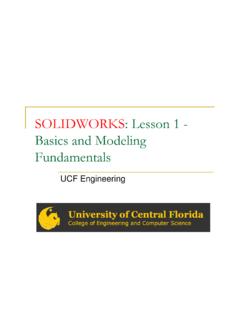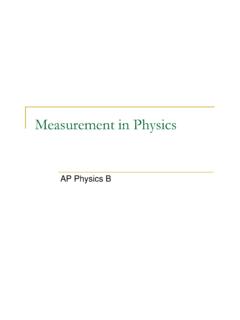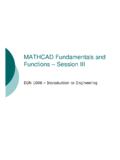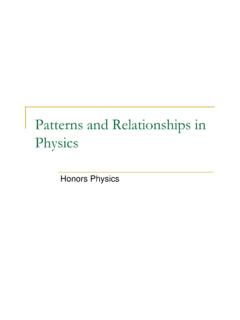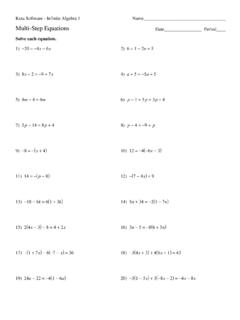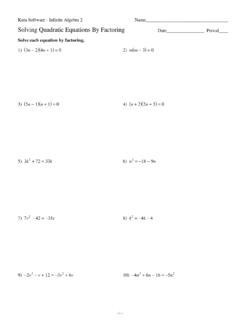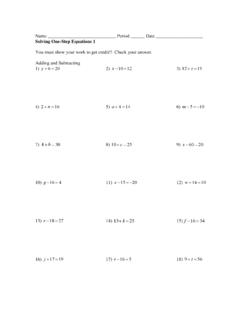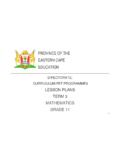Transcription of EGN1006 - Mathcad fundamentals and functions II
1 Mathcad fundamentals and functions Session II. EGN 1006 Introduction to Engineering Mathcad . Matrix Operations and Graphing Indexing You can use an integer range variable to create and indexed array. The array MUST be indexed by the integer range variable so that the correct elements are filled. Enter: [i][:][0][;][10]. [time[](i placed as the subscript)[:]i/20. [i][:][time*10]. [i][=]. [time][=]. Making changes to the index Enter [x][:][time*20]. [x][=]. Now change i in the time equation to i2 and notice the changes. Indexing Indexing Summary The variable i is simply a range variable while time and x are called one- dimensional arrays or matrices indexed with i . Notice that the initial default index or origin for the array is automatically set to ZERO. The origin may be changed by re- assigning a value to a pre-defined constant Changing the Origin Enter: [ORIGIN][:][1]. Place this at top of worksheet Notice what happens!]
2 Now DRAG the box so it is UNDER the time equation. Now DRAG the box so it is UNDER all of the worksheet. You should notice that the values for the origin change on the data table Querying the array If you have a ton of values in the array and you want to know, for example, what is the time at 3? Enter: [time3]=. Note: Remember that to get the INDEX. subscript you use the LEFT bracket [ not the PERIOD which is used for a TEXT. SUBSCRIPT. Matrix Definitions Multi-dimensional arrays can be defined by specifying multiple indices separated by commas. Enter the following: [i][:][0][;][10]. [j][:][0][;][10]. [Ai,j][:][(i2+j3)/4). [A][=]. Then evaluate: [A2,3][=]. Note: In this example i was the ROW and j was the column Matrix Definitions A matrix or array can also be directly defined by specifying its dimensions and entries using the insert-matrix or the <Ctrl-M> shortcut. Enter the following: [A][:][<Ctrl-M>].]]
3 Specify the # of columns and rows and enter the elements of the new matrix Reading Data Files Files may be imported into Mathcad in the form of matrices by using the following command A:=READPRN( ). Any extension can be specified You must provide the full path name if the file is not in the Mathcad directory After execution of this command, the ordered values on the will be imported into A. in the form of an Ai,j ordered matrix Entering Data Files Enter the following: [M][:][READPRN( c:\desktop\UCF\ )]. [M][=]. To query enter [M3,4][=] NOTE: Use the left bracket to subscript down Writing Data Files A matrix can be exported into a data file by using the following command: WRITEPRN( ):=A. Any extension can be specified The data file will be written in the directory MATCAD is in After the execution of the command the ordered values of matrix A will then be exported to the data file named Writing Data Files Enter the following [D][:][M][*][2].
4 [D][=]. [WRITEPRN][( c:/desktop/UCF/data2. txt )][:][D]. Then go to your desktop, open up the UCF. folder and check to see if a file called was created. Notice the time and date of creation. Editing the data file Suppose the file contains values that need to be adjusted for accuracy and precision. Enter this above the WRITEPRN command: [PRNPRECISION][:][2]. [COLUMNPRECISION][:][2]. Then click inside the WRITE command box and hit ENTER. This will RE-SAVE the data file with the adjusted values. Open the file to see and verify the new changes. Matrix Operations A matrix can be operated over using built in Mathcad fuctions. Adding or subtracting C:=A+B. Multiplying by a scalar C:=h*A. To access a column in a matrix use <Ctrl-6>. V:=A<3> where V = vector Matrix Operations Transpose of a matrix using <Ctrl-1>. G:=FT. Matrix Multiplication is UNITS are CONSISTANT!!! C:=A*B. Determinant (for square matrices) using <shift-\>.
5 Note: Square means same # of rows as columns D:=|A|. Inverse ( for square matrices) using ^-1. D:=A-1. Matrix Operations Do the following: Display matrix A from earlier in the lesson Create another FIVE by FIVE matrix and call it B. Enter the values then enter [C][:][A][+][B]. [C][=]. Matrix Operations Enter the following: [D][:][ ][*][A]. [D][=]. [E][:][AT] using Ctrl-1. [V][:][E<0>] using Ctrl-6. Matrix Operations- The determinant What are we doing? The beginnings of matrices and determinants goes back to the second century BC although traces can be seen back to the fourth century BC. However it was not until near the end of the 17th Century that the ideas reappeared and development really got underway. Matrix Operations- The determinant It is not surprising that the beginnings of matrices and determinants should arise through the study of systems of linear equations . The Babylonians studied problems which lead to simultaneous linear equations and some of these are preserved in clay tablets which survive.
6 For example a tablet dating from around 300 BC contains the following problem:- There are two fields whose total area is 1800 square yards. One produces grain at the rate of 2/3 of a bushel per square yard while the other produces grain at the rate of 1/2 a bushel per square yard. If the total yield is 1100 bushels, what is the size of each field. Matrix Operations- The determinant The Chinese, between 200 BC and 100 BC, came much closer to matrices than the Babylonians. Indeed it is fair to say that the text Nine Chapters on the Mathematical Art written during the Han Dynasty gives the first known example of matrix methods. First a problem is set up which is similar to the Babylonian example given above:- There are three types of corn, of which three bundles of the first, two of the second, and one of the third make 39 measures. Two of the first, three of the second and one of the third make 34.
7 Measures. And one of the first, two of the second and three of the third make 26 measures. How many measures of corn are contained of one bundle of each type? Matrix Operations- The determinant Now the author 1 2 3. does something quite remarkable. He sets up the 2 3 2. coefficients of the system of three 3 1 1. linear equations in three unknowns as a table on a 26 34 39. 'counting board'. Determinant Consider a triangle with vertices at (x1,y1), (x2,y2), and (x3,y3). If the triangle was a right triangle, it would be pretty easy to compute the area of the triangle by finding one-half the product of the base and the height. However, when the triangle is not a right triangle, there are a couple of other ways that the area can be found. Consider the triangle with vertices at (-2,2), (1,5), and (6,1). Determinant The triangle can be enclosed in a rectangle. The vertices of the triangle will intersect the rectangle in three places, forming three right triangles.
8 These triangles are denoted A, B, and C in the picture. Determinant- A geometric technique The area of the triangle we desire will be the area of the rectangle minus the areas of the three triangles. Area of triangle A = 3 ( 3 ) / 2 = 9/2. Area of triangle B = 5 ( 6 ) / 2 = 15. Area of triangle C = 8 ( 3 ) / 2 = 12. The sum of the areas of the triangles is 9/2 + 15 +. 12 = 63 / 2 or The area of a rectangle is base times height, so the bounding rectangle has area = 8 ( 6 ) = 48. The area of the triangle in the middle is the difference between the rectangle and the sum of the areas of the three outer triangles. Area of triangle = 48 - = Determinant It turns out that the area of a triangle can also be found using determinants. What you do is form a 3 3 determinant where the first column are the x's for all the points, the second column are the y's for all the points, and the last column is all ones.
9 Determinant (6*5)-(1*-1)=31. (6*2)-(-2*-1)=10. (1*2)-(-2*5)=12. 31-10+12=33. 33/2= This is the same value for the area as the geometric technique What are determinates used for? Solving MULTIPLE sets of equations The determinant is actually the CROSS PRODUCT in vector physics Used to define Integrals in Calculus Decryption and coding Determinant Insert a page break, then [A]=. [B]=. Enter the following [D][:]|A| - using shift \. [D][=]. [E][:]|B| - using shift \. [E][=]. Inverse ( for square matrices) using ^-1. F:=A^-1, then F= or A-1=. Other Matrix functions Other functions include: matrix(r,c,f). indentity(c). Enter d:=indentity(6) then d=. submatrix(A,r1,r2,c1,c2). Enter A=, then c:submatrix(A,0,2,0,3). c=. augment(A,B). Enter C:=augment(A,B) then C=. stack(A,B). Enter C:=stack(A,B) then C=. Additional Matrix functions sort(V) for 1-D arrays(Vectors). reverse(V). csort(A,c#). rsort(A,r#).
10 Matrix System Solvers (The Bottom Line). To solve a system of simultaneous linear equations in Mathcad . [A]{x}={b}. The system may be re-ordered as {x}=[A]-1{b}. Or the function lsolve() may be used x:=lsolve(A,b). Matrix System Solvers Add a page break and enter A=. Then the determinant, d:=|A| using shift-\, then d=. Define b:=(insert-matrix) with 5 rows and 1 column, Enter in 5,7,-8,3,5). Enter: x:=A^-1*b, then x= also x:=lsolve(A,b) then x=. Matrix System Solvers Notice that the direct calculation of the inverse of A times b gave you the same solution as the lsolve command using A and b. These are TWO. COMPLETELY different ways to solve the equations and YOU WILL. get different answers if you have over 200. equations . The lsolve command is faster. Plotting Data Plotting in Mathcad can be done two different ways: Using indexed variables Using functions Plotting with Indexed Variables Enter the following: i:= timei:=(i/100)2.

